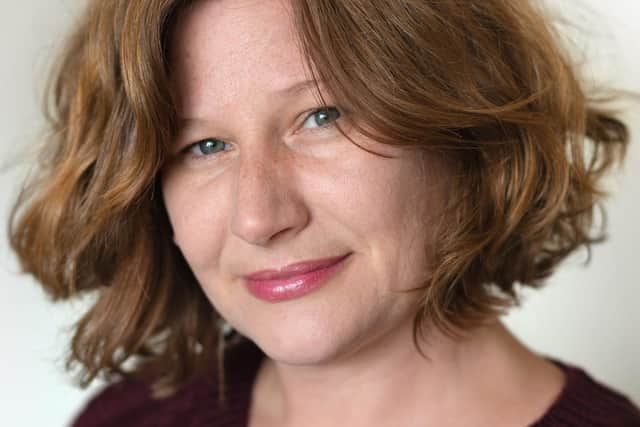Eleanor Thom talks history, untold stories, and more at the Edinburgh Book Festival
Her granddaughter doesn’t. Her novel Connective Tissue is, she insists, “not a Holocaust book”: and indeed, its tracks don’t run on the tragically predictable lines of so much fiction set then. Instead, Dora escapes to Britain – the only country in Europe that will take her, she is told – in January 1939. She doesn’t want to go, because it means leaving her baby Ruth behind. But she has received an official letter telling her that, because she is stateless, she has just three weeks to get out of Germany. She doesn’t speak English and she has hardly any money, yet she is one of the lucky ones. All the rest of her family - including her childless cousin and her husband, who bring up Ruth, are killed in the camps.
“I felt Dora’s story was unusual,” Thom tells me. “She was working-class and grew up in the heart of Berlin, just north of Alexanderplatz. All her family were living a hand-to-mouth life, and that was true for 40 per cent of Berlin’s Jewish population. Even Holocaust historians acknowledge that these people’s stories haven’t particularly been told.
Advertisement
Hide AdAdvertisement
Hide Ad“Few of them managed to escape, because they didn’t have either the money - a place on the Kindertransport cost the equivalent of thousands of pounds - or the contacts abroad who would have helped them find places to go. I wanted to make their lives palpable for the reader, the centre of the story rather than the background.”
Thom does this to powerful effect, somehow dodging the more obvious tropes of fiction set in Nazi-era Germany. These are, in any case, already in the reader’s mind. When Dora gives birth to her daughter in a German hospital, for example, we might not know the precise chronology of how it will be affected by antisemitic laws, but we know that something bad is coming. It’s the same when she goes to the mother and baby home in Niederschonhausen in 1937: the staff are kind, the place is well-run, but maybe we’ve read Ishiguro’s Never Let Me Go or maybe we’ve seen so many Holocaust documentaries: either way, there’s always a gap of horror for the imagination to rush into.
In the section set in the present, Thom - lightly fictionalised as Helena rather than Eleanor - is giving birth in an Ayrshire hospital. There are problems with uterine fibroids and the doctors are asking questions about genetics; meanwhile, one of the mothers in the maternity ward has her baby taken away by social services. Parallels with the past bubble up, and it’s clear that Thom is fascinated by the whole theme of how much or how little flows through from one generation to the next. All the same, for a while I wondered why she felt the need to write herself into the story. The answer she gives is entirely logical but one I’ve never heard from anyone writing historical fiction.
“It was an ethical question, really,” Thom explains. “I wanted to be upfront about the fact that it wasn’t Dora’s testimony because I couldn’t speak to her about any of this – or to anyone who was actually there. I can’t be sure that I’ve got all the details correct, and there are some gaps that I won’t ever be able to fill in.
“Dora took all her cousins’ names to the grave. Neither they nor her daughter Ruth were recorded anywhere. I became a kind of a witness and I felt it was my responsibility to tell their story to the best of my ability. But it’s not just about Dora - it’s also about my own generation and what happens in a family when the past is cut off like that. I wanted the novel to be both things.”


The whole project has taken her ten whole years, and much of Helena’s research mirrors Eleanor’s as they both go to Berlin and get to work in the archives. Because Dora’s first 22 years in Germany are a complete mystery, there is a real sense of discovery about the sections set in the present - even though, as Thom admits, “their background is more fictionalised than the ones set in the past”. (For the last four years, her passion for researching and writing about ordinary lives has also been something she brings to her work as a writer-in-residence with the Edinburgh book festival, which involves encouraging creative writing in places like Wester Hailes or North Edinburgh.)
Gradually, we find out more about Dora and her family. About the childless seamstress cousin and her tailor husband who lived just across the back courtyard in Berlin and brought up little Ruth as if she was their own. About Dora trying to make a new life in London, where she works as a maid and sends off scores of letters home – still, somewhat miraculously, in the archives – while constantly checking up at Bloomsbury House, the centre for all Jewish refugee inquiries in London, for any updates about the earliest that she’ll be able to put her daughter on the first train to England.
Advertisement
Hide AdAdvertisement
Hide AdThe end will come in March 1943, when Ruth and the childless couple looking after her are caught up in the Farbikaktion, the last major round-up of Berlin’s Jews. We will, however, be spared both that and what happened next. Instead, our memories will be, not of moments of terror but of whole lives – forgotten maybe but here lovingly resurrected, the invisible made visible once more, the disappeared back in front of us as if they were never taken away.
Eleanor Thom and Wiz Wharton, Edinburgh International Book Festival, 20 August, 4pm. Connective Tissue is published by Taproot Press, price £11.99.